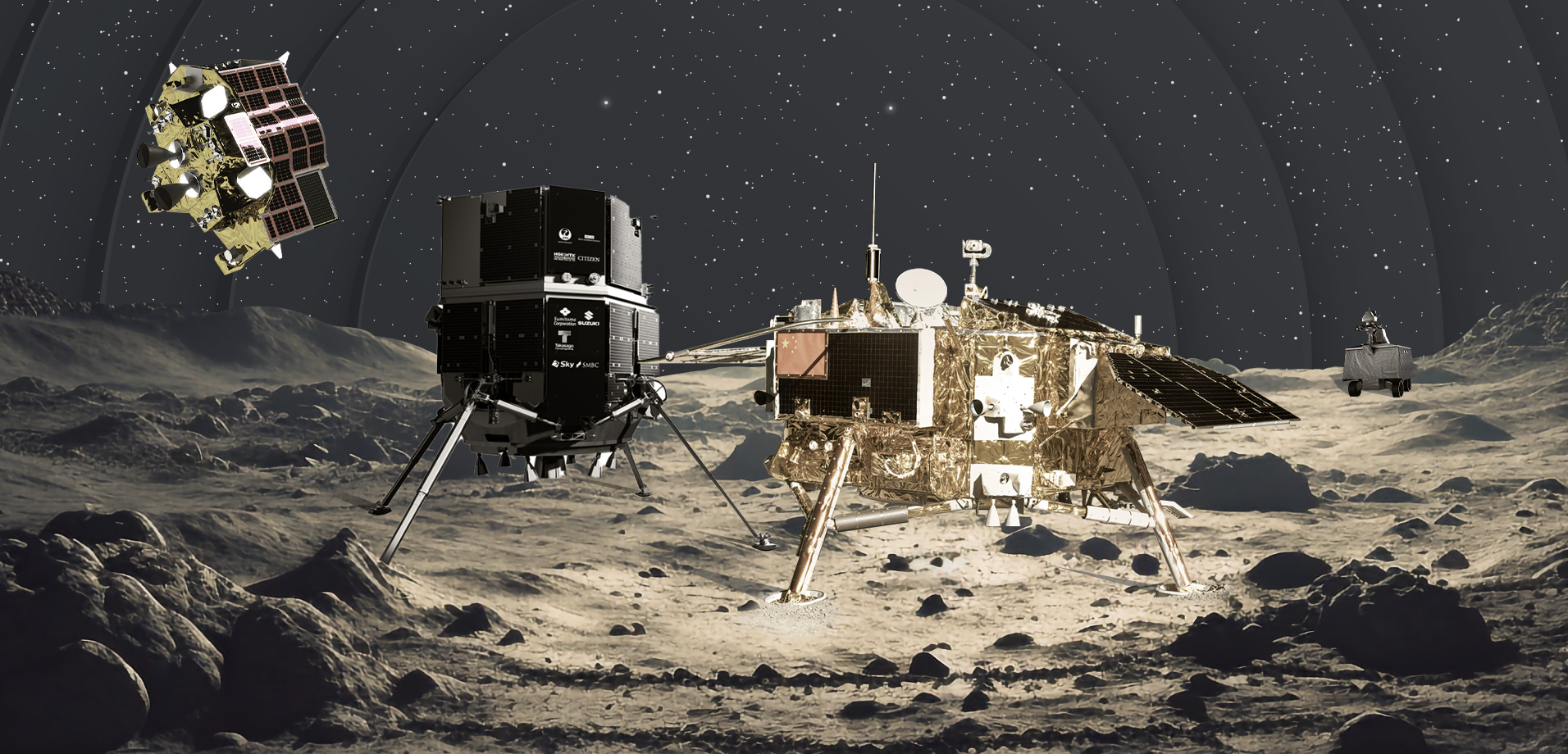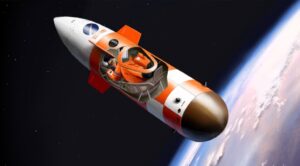Lunar Rovers of Today and Tomorrow: Who’s Exploring the Moon?
20th Oct 2023
Lunar rovers are back en vogue. A golden age of space exploration focused on lunar exploration, and while that seems like it is a long time ago, Chandrayaan-3 has brought the moon back into the forefront of people’s minds.
The Chandrayaan-3 mission became the first to land on the uncharted south pole of the moon when it made a successful soft landing just days after a Russian craft crash-landed nearby. This feat also heralded a historic day for Indian space exploration.
After initial successes, however, the Indian Space Research Organisation (ISRO) has not been able to establish communication with the Vikram lander or the Pragyan lunar rover that should be relaying vital information. The mission has given us the first-ever pictures taken near the Moon’s south pole, but India may be going back to the drawing board.
A Brief History of Lunar Rovers
Lunokhod was a Soviet Union craft that landed on the Moon in 1970, and it became the first robotic lunar rover to move freely around the moon, or any other celestial being, for that matter. The Soviet Union had attempted a prior launch in 1969, but failed to get the first Lunokhod Rover to the Moon.
The solar-powered craft had a large convex lid and had a bathtub-like appearance. It was equipped with a lot of gear for observing and understanding the Moon as well as communicating with Earth, including a helical antenna, television cameras, and a soil density checking device. Also, an X-ray telescope and spectrometer were onboard.
NASA’s lunar missions were still ongoing, and the iconic American ventures to the lunar surface captured the imagination in the 1960s and 1970s. Shortly after the crewed landing on the moon, NASA sent three lunar rovers on board the missions Apollo 15, 16, and 17.
1971’s Apollo 15 saw the first lunar vehicle by NASA, a craft that had been in production for many years prior. It was made by Boeing and three of the rovers were built, costing around $40 million. The Lunar Roving Vehicle weighed 460 lb and could carry two astronauts as well as their equipment, with each wheel having its own 200W electric motor.
The Apollo 15 rover had a plaque, reading: “Man’s First Wheels on the Moon, Delivered by Falcon, July 30, 1971”.
The same design of the rover was used in Apollo 16, and Apollo 17, as NASA collected samples and furthered the global understanding of the Moon. By the Apollo 17 mission, the Lunar Roving Vehicle was able to traverse 12.50 miles (20.12 km) in one trip.
New age of Moon exploration
After decades of relatively little movement from NASA (compared to Apollo days, anyway) new missions are looking to better understand the Moon. CADRE’s three small lunar rovers could go to the Reiner Gamma region of the Moon as early as 2024, before they will charge from the Sun, and then spend around 14 Earth days (one full lunar day) conducting a number of experiments.
On top of this, NASA’s Artemis mission also sees the country work with the Australian Space Agency to send an as-yet-unnamed lunar rover to the Moon, which could happen as early as 2026 depending on the success of the mission. “Drawing on Australia’s world-leading remote operations expertise, the rover will collect lunar soil, known as regolith,” the agency said upon the release of this news. “NASA will attempt to extract oxygen from the sample. This is a key step towards a sustainable human presence on the moon.”
How many lunar rovers are on the Moon?
The three NASA Lunar Roving Vehicles are still on the Moon (leftovers from the Apollo 15, 16, and 17 missions). They were designed to be unpacked before being driven but not brought back to Earth, meaning they’re still up there somewhere, along with other lunar explorers that have crash-landed or completed their operations.
What is a Lunar Rover Used For?
A lunar rover is a space vehicle designed to move on the surface of the Moon, and they are used for either observation via cameras or for collecting other forms of data, including samples from the surface of the moon or scientific measurements such as radiation.
Current Moon Rovers
Chang’e-4 and Yutu-2
China’s mission to the Moon’s farside made history as boasting the longest-lived lunar rover, the Yutu-2. It is also the first farside landing ever to have been successful.
Chang’e-4 made its landing back in January 2019 and since then has been providing crucial data. It is exploring Von Kármán crater, which was the spot of an ancient lunar impact that could have exposed the Moon’s mantle. On top of this, Yutu-2 is gathering data on the Moon’s history to try and gain more understanding of the early Solar System.
The LROC site has published data, including the landing site: “Flipbook and Zoomable Traverse sections and a new option to alternate the Flipbook sorting order. Users can now toggle the interactive image library between the default local solar time to the newly added chronological order, making it easier to follow robotic rovers like Yutu 2 as it progresses over time.”
Onboard the Yutu-2 is a Panoramic Camera (PCAM) that can acquire 3D images, a ground penetrating radar that can probe into the surface of the Moon, and an Advanced Small Analyzer for Neutrals (ASAN), an energetic neutral atom analyser that was given to the mission by the Swedish Institute of Space Physics (IRF). Both the lander and Yutu-2 rover have a radioisotope heater unit (RHU) to heat them through the lunar nights.
Hakuto-R Mission 1: Japan and UAE’s Failed Approach
Failure really can be a stepping stone to success in space exploration. That is a line that gets wheeled out time and time again, with good reason.
Hakuto-R Mission 1 may not have been a success but it underlines the intentions of ispace and the Mohammed bin Rashid Space Centre (MBRSC), whose Rashid rover was onboard the craft.
Rashid had both a microscopic camera and a thermal imaging camera, as well as a Langmuir probe that intended to study Moon dust, and why it has a sticky consistency. The rover was going to mainly focus on the Moon’s surface and its mobility as well as the interactions with lunar particles.
The lander was also carrying Tomy and JAXA’s SORA-Q transformable lunar robot which aimed to transmit images of the lunar surface and the behaviour of the regolith for further evaluation.
Unfortunately, on 25th April 2023, contact with the lander was lost and it was determined that the lander had crash landed when it ran out of propellant.
Hakuto-R Mission 2 is planned for 2024.
Smart Lander for Investigating Moon (SLIM)
Smart Lander for Investigating Moon (SLIM) is a lunar lander developed by the Japan Aerospace Exploration Agency (JAXA), which is carrying two different rovers.
The SLIM Lander launched on 6th September 2023 and as of the start of October, the lander has executed its trans-lunar injection burn. On 4th October, it passed the lunar surface at a relative speed of 1.47 kilometres per second.
Should it be successful, it will mark Japan becoming the 5th country to soft land on the surface of the Moon. Though the mission was delayed, the lunar rovers carried onboard have a lot of promise.
The two rovers are:
- Lunar Excursion Vehicle 1 (LEV-1). A rover that has direct-to-Earth communication equipment as well as UHF band antennas, and wide-angle visible light cameras. It also has a thermometer, radiation monitor, and inclinometer to help understand the surface of the Moon.
- Lunar Excursion Vehicle 2 (LEV-2) is also known as Sora-Q, and this is a tiny rover developed by JAXA in joint cooperation with Tomy, Sony Group, and Doshisha University. It has two tiny cameras and can cleverly change shape to “run” on the lunar surface. LEV-2 succeeds a rover that was on board the Hakuto-R Mission 1, crashing before deployment.
Planned Lunar Rovers – Upcoming Launches
Both private companies and space agencies around the world are working on planned launches.
Mission One: The VIPER Rover (2024)
The American interest in the Moon is heating up once again. In 2020, Astrobotic received a contract for the Commercial Lunar Payload Services program and will take the VIPER rover to the Moon in November 2024, all being well.
The VIPER rover will be around the size of a golf card and has the main goal of prospecting for resources. Numerous space agencies have concluded that water is distributed across the Moon, but very thinly, so the task of mapping its distribution and purity can help to understand the Moon better, as well as whether or not it can be a resource for future space missions such as Mars missions.
The VIPER rover is part of the Lunar Discovery and Exploration Program which is managed by NASA and runs alongside the Artemis program, which plans to launch further crewed missions.
The rover will be equipped with a drill as well as many other scientific instruments. A Neutron Spectrometer System will detect hydrogen and find potential sites for drilling.
The Regolith and Ice Drill for Exploring New Terrain will drill to look for samples underneath the Moon’s surfaces.
The NIRVSS will analyse mineral and volatile composition to help to understand any hydrogen deposits and whether they are part of water or hydroxyl.
YAOKI (2024)
YAOKI, announced in 2019 and developed by Japanese company Dymon, hopes to be the first fully-commercial rover for exploring the surface of the Moon, in partnership with NASA’s lunar transportation mission. It will be delivered to the Moon onboard Intuitive Machines’ Nova-C lunar lander.
The craft is part of Dymon’s heady hopes for the future, as they plan to help contribute to mobility systems for NASA’s lunar transportation missions, and even support the construction of a lunar base in the future.
Not a huge number of details have been released about the YAOKI rover.
Chang’e 7 (2026)
An upcoming launch in the Chinese Lunar Exploration Program is the 2026 launch of Chang’e 7, which will explore the south pole of the Moon. As well as a lunar rover, the payload will also include an orbiter and a mini-hopping probe.
The ambitious mission will carry a huge number of scientific instruments including a number of analysers, panoramic cameras, probes, a Lunar Penetrating Radar, Lunar Raman Spectrometer and a Water Molecule and Hydrogen Isotope Analyser.
The following goals of the mission have been announced:
- obtain information on lunar inner ring structure, mineral/element components, electric and magnetic fields, heat flow, and gravity fields
- study the distribution and sources of lunar water and volatiles and directly confirm the presence and source of water ice on the Moon
- image energetic neutral particles in the Earth’s magnetotail with high spatial, time, and energy resolution
- study the lunar environment, including the surface magnetic field, lunar dust, and radiation to elucidate the causes of surface magnetic anomalies.
Chang’e 8 (2028)
Change’s 8’s mission details are not fully clear yet, due to the fact that it won’t launch until 2028, but its ambitious nature is clear.
According to syndicated data on NASA Space Science Data Coordinated Archive, “Chang’e 8 is designed to test technologies necessary to the construction of a lunar science base. It will also conduct surveys and scientific experiments.”
The launch and rover carried will be able to expand on the activities of Chang’e 7, plus serve as the basis for a research station to be constructed for ongoing use.
Chandrayaan-4 (2026-2028)
The Lunar Polar Exploration Mission (LUPEX), also known as Chandrayaan-4, is a planned joint mission by the Indian Space Research Organisation (ISRO) and Japan Aerospace Exploration Agency (JAXA).
It will send an uncrewed lunar lander among its payload, precise details of which are yet to be unveiled. The rover itself will carry instruments by JAXA and ISRO, such as a drill to collect samples up to 1.5m deep under the surface, and instruments for water prospecting and analysis.
An Exciting Future For Lunar Exploration
The majority of the largest space agencies are putting a lot of resources into better understanding the Moon, as well as the resources that can be found there. After decades in the wilderness, NASA is sending uncrewed and crewed missions to explore the Moon, plus China’s ambitious plans include creating a permanent research station. What can our satellite tell us about the Earth?
![Beauty of the Pink Moon And Lyrid Meteor Shower in This Week’s Best Astrophotos [19-26 April] Beauty of the Pink Moon And Lyrid Meteor Shower in This Week’s Best Astrophotos [19-26 April]](https://orbitaltoday.com/wp-content/uploads/2024/04/Pink-Moon-is-on-its-way-above-the-mountains-1-300x300.jpg)





Thank you for your comment! It will be visible on the site after moderation.